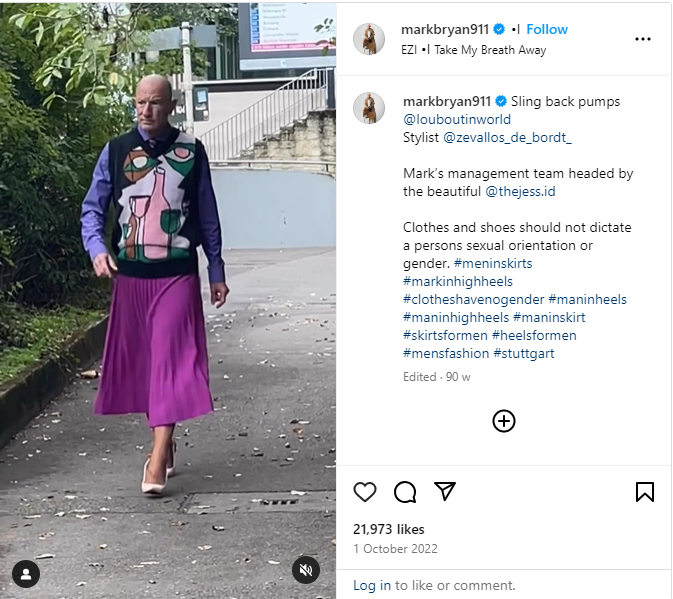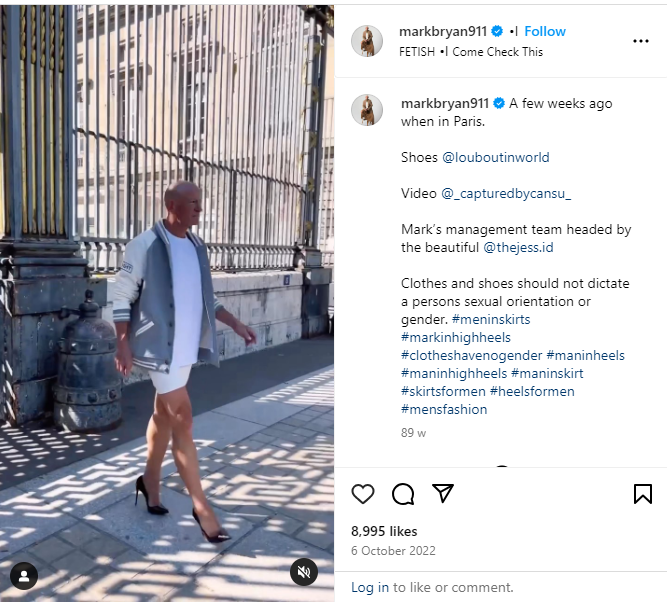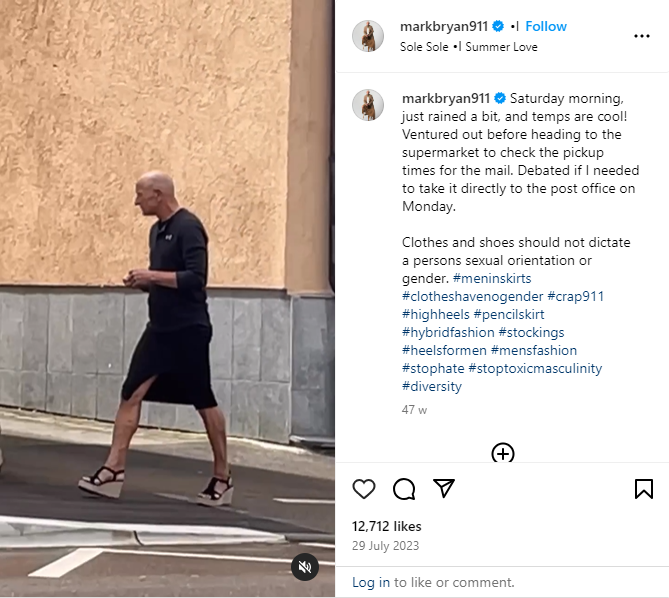
Mark Bryan is a robotics engineer who has been married for 11 years and has a daughter. He identifies as straight and chooses to dress unconventionally. Bryan is an American living in Germany, and he doesn’t believe that fashion has to be gendered. You can find Bryan wearing a skirt and heels to work or out anywhere else he goes on any given day.
Bryan said he doesn’t like how limited men’s choices are in the fashion department, especially when it comes to office attire. Men’s pants only come in a few colors, mostly black, gray, dark blue and the occasional pinstripe, and cuts.
The stylish dresser believes that if women are allowed to wear pants, men should be able to wear skirts and dresses as well. Bryan likes how skirts come in many styles and patterns – and many more colors – unlike men’s clothing.

Bryan prefers to mix traditional gender looks by wearing masculine attire on his top half, like a blazer and tie, and traditionally feminine attire on the bottom half. He will typically wear a pencil skirt and four-inch heels on the bottom.
Wearing high heels is no problem for Bryan. He first learned how to do it when his college girlfriend asked him to wear high heels while dancing with her so that they were on the same level. They continued this for over a year.
Bryan doesn’t let stereotypes or assumptions stop him from dressing in a way that brings him joy. He challenges expectations and does so unapologetically. Keep reading to hear what Bryan has to say about his fashion choices.
Bryan has a very clear idea about how he likes to dress. He told Bored Panda: “To me, clothes have no gender. I prefer skirts to dresses. Dresses don’t allow me to mix the genders. I prefer a ‘masculine’ look above the waist and a non-gendered look below the waist. It’s all about clothes having no gender.”
He continued: “I am old enough to remember that in school, the girls could not wear pants. Pants have now become a non-gendered article of clothing. So why can’t skirts and heels be non-gendered? Besides, men wore heels before women did. Maybe not today’s stiletto-style heels, but men did wear heels before women.”

Bryan is correct about that. High heels can look back on a long history. Although historians and archaeologists cannot date their invention clearly, they have been around at least since the 10th century. And they were not a fashion statement at first. No, the first recorded use of high heels was eminently practical: the Persian cavalry wore boots with heels, called a kalash or galesh, that made it easier for them to keep their feet inside their stirrups. This is, by the way, the same reason why cowboy boots have a small heel as well!
Since owning a horse was a sign of wealth, only well-off men could afford to wear these high-heeled boots. The use of them slowly spread across Europe, and high heels heels became one of the fashion signs of rich noblemen or traders. In fact, following the Great Schism of the Christian Church in the 11th century, even the pope wore high heels.
It wasn’t until several hundred years later that fashion slowly changed. During the 18th century, cultural concerns in Europe came up about the distinction between males and females and talk about what men and women should wear arose. This is the point in time where the belief that fashion is something effeminate and frivolous that “real men” shouldn’t care about hails from. Due to these changing beliefs, men largely abandoned high heels heels, as they were seen as impractical and mere accessories.

Bryan is one of the examples of how high-heels are slowly coming back as an accepted form of footwear for men. Although the engineer champions the option of wearing high-heeled shoes for men, he understands many people will look twice when they see him. He compares his style choices to someone who chooses to dye their hair bright colors. He explained:
“Take a person with bright green hair. Green hair is not normal. You look up and see this person, your mind tells you it’s a person with green hair, you think to yourself, that’s odd or interesting, then you go back to do what you were doing and don’t give it another thought. I believe this is the same when people see me in a skirt and heels.”
Bryan doesn’t have to struggle to find skirts and heels that fit him either. He wears a size 8 in skirts, and with smaller feet for a man, his shoe size in heels is 8.5. If you know a man who is considering trying out wearing heels and skirts too, Bryan suggests starting with a lower heel until you feel more comfortable walking in high heels.
What do you think of Mark Bryan’s style choices? Do you know any men who would try walking in high heels? Let us know, and be sure to send this along to your friends and family.
Expert Says Parents Should Ask Babies For Consent Before Changing Diapers

In the world of parenting, where dirty diapers are as common as cuddles, a new concept is shaking things up: seeking permission from babies before changing their nappies. It’s a notion that has sparked both curiosity and controversy, leaving many scratching their heads in disbelief.
Enter Deanne Carson, a self-proclaimed authority on sexuality education. In her bold claim, she suggests that parents should initiate a dialogue of consent from the very beginning of their child’s life. While it might sound unconventional, Carson argues that even infants can benefit from a culture of consent.
During a notable appearance on ABC, Carson shared her insights on instilling this concept in early childhood. She emphasizes the importance of non-verbal cues, particularly eye contact, in conveying the message that a child’s input matters. While it’s true that newborns can’t verbally respond, Carson suggests that a moment of anticipation, coupled with non-verbal communication, can lay the foundation for a respectful relationship between parent and child.
‘Sexuality expert’ says parents should ask for baby’s consent when changing nappies.
But as with any controversial idea, there are skeptics. Many online voices question the practicality of seeking consent from a baby who can’t comprehend the situation. Some even jest about the absurdity of expecting a verbal response from a newborn.
In the midst of this debate, another parenting guru, John Rosemond, throws his hat into the ring, arguing against the seemingly innocuous act of high-fiving children. According to Rosemond, such gestures undermine parental authority and respect, setting the stage for a lack of discipline in the future.
And what happens when baby says no? Do it anyway? Whoa now there is the real problem
— Glenda 🍃🌻🍃 (@TweetsbyGlenda) May 10, 2018
Either she has never wrestled a toddler during a change or worse, she just left hers in a shitty nappy until it was ready to consent. OMFG.
— Michael Lyten (@lytening67) May 11, 2018
— -@[email protected] (@feather1952) May 10, 2018
In a world where every parenting decision seems to carry weight, these discussions shed light on the complexities of raising children. From consent in diaper changes to the appropriateness of high-fives, every action and interaction plays a role in shaping the parent-child dynamic.
So, what’s the verdict? Are we overthinking parenting, or are these conversations vital for nurturing respectful relationships? As the debate rages on, one thing remains clear: parenting is anything but simple. It’s a journey filled with surprises, challenges, and yes, even dirty diapers. But through it all, one thing is certain – the quest for understanding and improvement never ends.



Leave a Reply